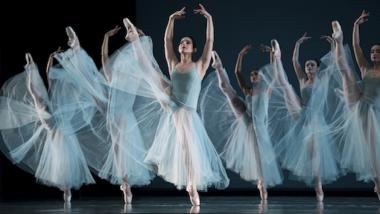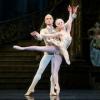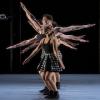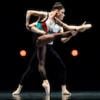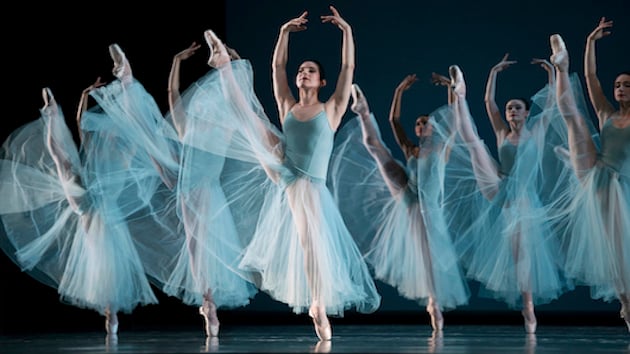
Artistic director Helgi Tomasson’s dedication of Serenade’s performances in San Francisco Ballet’s current repertory season to the late, magnificent ballerina Karin von Aroldingen, a friend and New York City Ballet colleague in the 1960s, was at once a sweet gesture and a master stroke. Like the repertory program itself, launched Tuesday night, the tribute warmly reflected the program’s links to George Balanchine’s choreography and company, his life and work.
Mingling nostalgia and virtuosity to brilliant effect, the show offered glimpses — at times more tentative than fully formed — of what may lie ahead for the neoclassicism Balanchine brought to his disciples and his heirs.
The 1935 Serenade, the first new ballet the Russian-born Balanchine presented in America, has been in the San Francisco Ballet repertory since 1952, and if it’s ever been done better, I missed it on both coasts. Set to the eponymous Tchaikovsky music, the ballet presents at the opening curtain a corps of women (14 here) in formation. Standing in their classical-length, pale-blue tutus, they move in unison, feet shifting from parallel into first position — quite literally the start of ballet — and things go on beautifully from there. Each dancer angles one arm above her head, as if they are shading themselves from the moon, or from some unspeakable glory yet to be. It’s a worthy premonition.
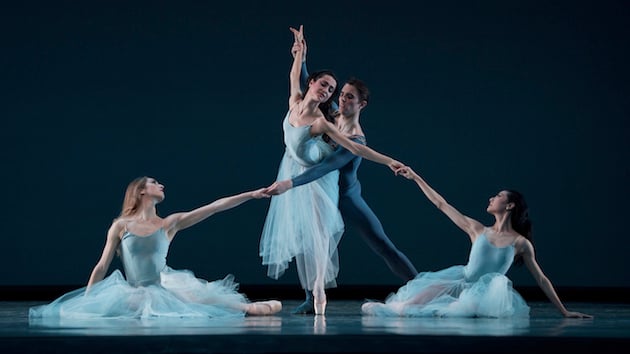
Serenade is the best kind of Balanchine. Choreographically, it has his distinctive interlacing of arms, denoting friendship and support, showgirl splits, charming soubrettish flirts and superb grand jetés, and a sequence where Yuan Yuan Tan falls down, her dark hair loosing and streaming around her. There comes, later, a darkly mysterious funeral cortege wherein the angelic victim (Jennifer Stahl) is borne, standing straight up on the men’s shoulders, into the wings. Serenade embodies stories without a plot — sorrow and salvation, heartbreak and hope. It’s perfect for Valentine’s eve, or anytime you’d like to rip your heart out and have it returned to you intact.
Tuesday’s fine principal cast also included Mathilde Froustey, Carlo di Lanno, and Luke Ingham, with soloists Isabella DeVivo, Koto Ishihara, Norika Matsuyama, Julia Rowe, Sean Bennett, Alexandre Cagnat, Nathaniel Remez, and Alexander Reneff-Olson.
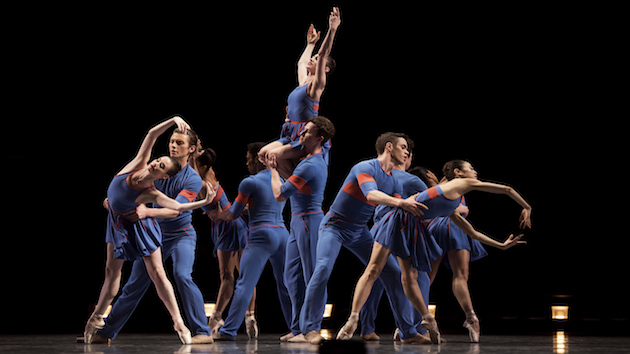
Two products of the New York City Ballet are choreographer Benjamin Millepied, a former principal dancer, and Justin Peck, a soloist and the City Ballet’s resident choreographer. Millepied’s The Chairman Dances — Quartet for Two, and Peck’s Rodeo: Four Dance Episodes were also on the program. Chairman, set to John Adams, was on the bill at the S.F. Ballet gala. It’s the one with a corps of five men and five women that concluded with a mysterious and seemingly out-of-place duet. Now Millepied has finished it, adding a strange couple of pas de deux to the one for a man and a woman. Now there’s also one for two men, and one for two women.
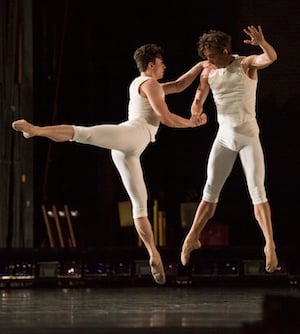
The music for this part is called “Christian Zeal and Activity,” the middle “hymn” movement from Adams’s American Standard. It includes amplified and reechoing vocal exhortations of the revival variety, a lot of rolling around on the floor, and some lovely, quiet partnering. But that’s just at the end. Before it, we have Millepied’s interpretation of The Chairman Dances: Foxtrot for Orchestra. Nothing about Millepied’s cheery choreography for this section seems to have anything to do with foxtrotting, no matter what the piece’s rhythm or the (uncredited) program says. It’s buoyant, but its athleticism, accentuated by soccer garb and leg warmers, isn’t conventionally foxtrotty, or in any way referential to movies of the early 20th century (the program said that, too). Everyone looks young and vibrant and as if Millepied has set them up for a good time. That’s charming, but somehow it doesn’t feel like enough. High quality dancing all round, though, led by Tan, Ulrik Birkkjaer, Stahl, and Benjamin Freemantle. Millepied’s reputation at this point seems to be running ahead of his execution. He’s fluent, but what he can make of it has yet to be determined.
On the other hand, there was Justin Peck’s Rodeo: Four Dance Episodes, which premiered at the City Ballet in 2015, making its local bow. Set to Aaron Copland’s score, first used for choreographer Agnes de Mille’s 1942 Rodeo, subtitled “The Courting at Burnt Ranch,” for the Ballet Russe de Monte Carlo at the Metropolitan Opera in New York, it is in the repertory of American Ballet Theatre and many others, but not the New York City Ballet. (The year after she made Rodeo, de Mille choreographed Rodgers and Hammerstein’s Oklahoma, a game changer for Broadway in that it developed the plotline via dancing.)
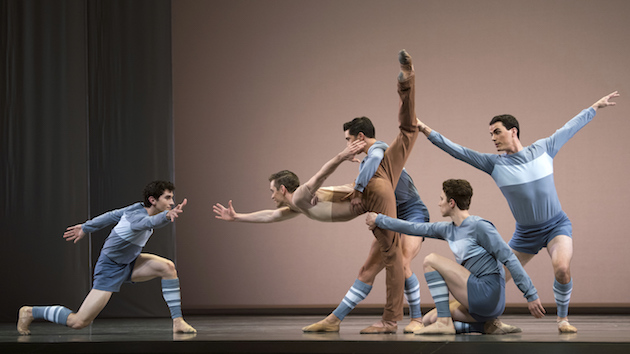
And now Peck, without any visible trappings of the old west, the cowboys, the Champion Roper, or the Cowgirl, thrilled the audience with his own Rodeo. Having read, written, and seen so much of de Mille and her Rodeo, which, of course, also brands Copland’s score on the memory, it was interesting to wonder if others in the audience were as triggered by the memory of the original, or if it was possible to get viewers that excited simply on his own terms (although there were many dance allusions to de Mille’s work, which I would identify as tributes, not plagiarism). Go see it, and wonder along with me.
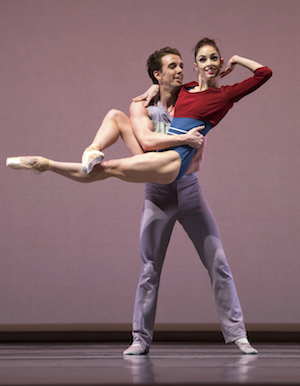
Rodeo: Four Dance Episodes puts the 14 men and a woman (Dores André) in casual clothes — pants and shirts with tints reminiscent of the western desert, sky and sunset. In lieu of a corral, cowboys dangle their feet at the stage apron. The Cowgirl is no tomboy; she’s a woman in short shorts and cowboy boots who has mostly made her mind up, a bright, confident dancer who, in her duet with Ulrik Birkkjaer, flirts and wonders and backs off a bit, then comes back to him full force. Their partnership is a delight. But that’s not until Episode Three.
Before that and after we can admire the company men, here all strength in their explosive leaps and beautifully focused extensions and turns (particularly the fireworks of Esteban Hernandez, Hansuke Yamamoto, and Wei Wang), and the matter-of-fact closeness of their friendships, including a readiness to touch each other’s arms or to link up companionably — in a way rarely seen in the 1940s.
Peck has a marvelous ear, an all-seeing eye, and whether he saw it live or not, an ability to capture the original Rodeo’s innovative touches within Copland’s bright rhythms, including a jump to imitate the buck of a bronco, the gesture and circling motifs of a lasso (de Mille told me she got it from tennis), the comic moment when one of the shorter guys lays eyes on the tall and lanky Birkkjaer, the Champion Roper without portfolio. But that terrific fourth-episode company finale you wish could go on forever, with everyone dancing across the stage — that feels like pure Peck.

